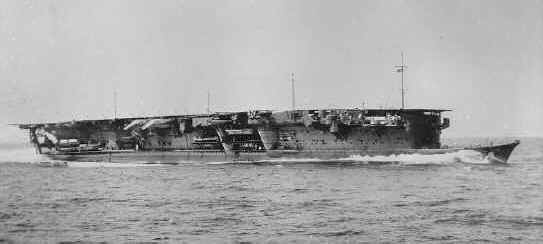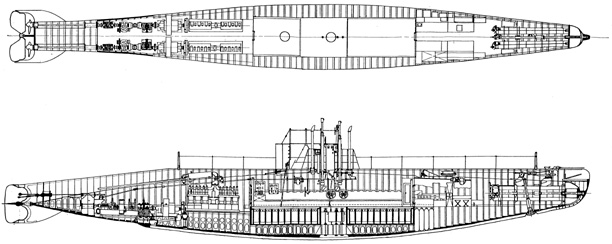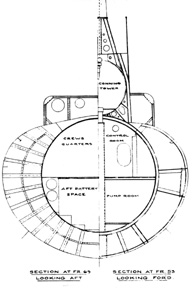

U.S. forces at Fort Mears met the first attack on June 3, with antiaircraft and small arms fire, but on June 4, the Aleutian Tigers (eight P-40s), engaged the Japanese planes in aerial dogfights. The U.S. planes were launched from Cape Field at Fort Glenn, a secret airbase on neighboring Umnak Island. The Japanese had thought the nearest airfield was on Kodiak, and Cape Field, disguised as a cannery complex, had remained undetected. The surprise aerial counter-attack destroyed four Val dive bombers and one Zero.

IJS Ryujo [Note: Aleutian climate so bitterly cold, it froze the island off this Japanese light carrier]

IJS Junyo only carrier to feature unique command center in middle of flight deck.

S-Boat plan and profile

S-Boat section at midship

USS S-35 in rough water--from The S-Boats

USS Narwhal (SS-167)

USS Nautilus (SS-168)


USS TRITON (SS-201)
TRITON was a most active and valuable member of the Submarine Force prior to her loss. In total, she is credited with sinking 16 ships, totaling 64,600 tons, and damaging 4 ships, of 29,200 total tons. Her first patrol, conducted around Wake Island, resulted in no damage to the enemy, but her second, in the northern part of the East China Sea, was very productive. In ten days she sank to freighters, and damaged a greghter-transport and another freighter. She went back to the East China Sea for hre third patrol, and again was most successful. She sank a trawler, two freighters, a freighter-transport, two sampans, and a submarine. The latter was I-64, torpedoed south of Kyushu on 17 May, 1942. TRITON's fourth patrol was made in the Aleutians. During it, she is credited with sinking two escort-type vessels.
On her fifth patrol, TRITON went into the Solomon area. She sank a tanker, and two freighters, in addition damaging a tanker of 10,200 tons and a freighter. She was credited with having sunk two medium freighters on her last patrol.

USS GRUNION (SS-216)
After shakedown out of New London, USS GRUNION (SS-216) sailed for the Pacific 24 May. A week later, as she transited the Caribbean for Panama, she rescued 16 survivors of USAT JACK torpedoed by a German U-boat, and conducted a fruitless search for 13 other survivors presumed in the vicinity. Arriving at Coco Solo 3 June, GRUNION deposited her shipload of survivors and continued to Pearl Harbor, arriving 20 June.
Lcdr. Mannert L. Abele took GRUNION out of Pearl on her first war patrol and, as ordered,proceeded to the Aleutian theater and patrolled westward from Attu on routes between the Aleutians and the Japanese Empire. On 10 July GRUNION was reassigned to the area north of Kiska. GRUNION made her first report on 15 July: Dutch Harbor received her message that, attacked by an enemy destroyer, she had fired three torpedoes at it, and missed with all.
Shortly after this message was received GRUNION sent another relating that she had sunk three destroyer-type vessels on 15 July. This message was garbled to the extent that details of the attacks were never learned (Japanese information reveals that GRUNION sank patrol boats 25 and 27 and damaged a third patrol vessel). On 19 July GRUNION, USS S-32 (SS-137), USS TRITON I (SS-201) and USS TUNA II (SS-203) were assigned areas in the approaches to Kiska, all to be there by daylight 22 July.
There was a strong concentration of enemy vessels at Kiska, this time being only a month and a half after the enemy had taken that island. The vessels patrolling there were told to watch particularly on the afternoon of 22 July 1942 for departing enemy naval vessels, since our own surface forces were scheduled to bombard Kiska that afternoon. The bombardment did not take place in accordance with the original plans, but our forces did stage the operation on 28 July and GRUNION was told to guard the exits from Kiska during darkness on this date. On this day GRUNION reported an attack on unidentified enemy ships six miles southeast of Sirius Point, Kiska. She had fired two torpedoes, made no hits, and been depth charged, but sustained no damage.
GRUNION's last transmission was received 30 July 1942. She reported heavy antisubmarine activity at the entrance to Kiska, and that she had ten torpedoes remaining. On the same day, GRUNION was directed to return to Dutch Harbor. She was not contacted or sighted after 30 July, despite every effort to do so, and on 16 August was reported lost. Planes observing the approaches to Kiska for indications of enemy salvage operations in connection with GRUNION reported negatively.
Japanese antisubmarine attack data available now record no attack in the Aleutian area at this time, and GRUNION's fate remains an unsolved mystery. No enemy minefields are known to have been in her area; thus her loss may be presumed to have been operational or as a result of an unrecorded enemy attack.
GRUNION received one battle star for World War II service.